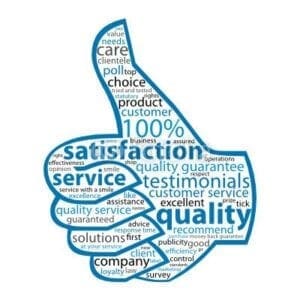Customer Experience Management (CEM) is a multi-tiered concept that begins with a consumer’s very first interaction with your brand. That might be through an advertisement seen about your offerings on social media, an interview or presentation given by one of your brand ambassadors for an industry publication, or even a word-of-mouth recommendation from an associate.
That first impression sets the tone for a relationship that follows and evolves over time. It is the reason that alignment within your organization is critical. Not only is it important to meet every expectation created through that first interaction, brands with a true customer experience culture strive to exceed those expectations through their sales, onboarding, support, training, and success structures.
In a recent interview, Global Senior Director of Client Experience at ADP Nicolle Paradise says, “The competitive battleground is about how successful customers are.
“They don’t care about your features, they don’t care about your product, or your roadmap. They care about how effortless their experience is and how quickly they can get to efficiency for their business. Putting the client at the center of that focus is what all businesses need to do.”
It is with that same attitude that we explore the intricacies of the customer experience and the elements, tools, and techniques that take customer experience from good to great, helping propel organizations into a viral growth loop of happy customers adopting, finding value, and becoming ambassadors for your brand.

The Ideal Customer Profile
The ideal customer profile (ICP) is a descriptive characterization of the best-fit client for your product. It defines who will potentially get the greatest benefit from using your product or service while bringing the most value to your business. Looking at your ICP through the lens of the Pareto principle that 20 percent of your customers typically account for 80 percent of your revenue.
According to customer success growth expert Lincoln Murphy, the ICP should dictate everything from the features and functionality of your product – or what should make up your service offering – to the words you use and the emotion you tap into with your marketing.
“I think people forget that you actually get to choose your customers. You get to choose who you want to do business with. So creating an ideal customer profile isn’t limiting…it’s empowering!” Murphy says.

Determine Product Market Fit
Developing your ICPs begin with determining the product-market fit. You need to ensure at the out-set that your product fully meets market expectations as well as those of the clients you’re bringing onboard. Building a product that is intentionally designed with the user in mind eliminates a huge chunk of work down the line involving painful support processes and training.
You can create your ICP by:
- Brainstorming specific problems you are solving for your customer
- Reverse engineer your areas of success by looking for other customers who may fit
- Survey existing clients to better define your value proposition
- Dig into website metrics to help pinpoint the target audience
- Analyze social-media content for areas of high engagement
- Keep tabs on your competitors and the lead magnets they’re deploying

Integrated Sales and Marketing
Aligning your sales and marketing efforts with what you have going on in customer support is critical. By understanding the desired outcome for the customer, sales can ensure it is not pitching something that can’t be delivered. Sales and marketing should also have deep knowledge of the ICP, to mitigate the risk of acquiring bad-fit customers who might be dumped on the doorsteps of customer support.
Organizations have made strides in improving their onboarding processes in recent years, bringing to the surface the disconnect between sales and the rest of the business.
As you grow your business it is important to put the tools in place that enable your teams at every level to be successful.
As a result, what ends up happening is customer experience or customer support becomes specialized as organizations grow. Effort needs to be made to ensure that customer culture does not remain as a specialized or a siloed division. New and relevant information needs to be infused throughout – from product marketing and sales, to support and growth.
Customer Experience Culture
Customer-centric organizations adopt deeply ingrained principles that are celebrated and injected into every role within the business – from senior leadership, right down to front line specialists.
By putting yourself in your customer’s shoes you really get an end-to-end understanding of what it’s like to work with your company and see how effective the product or service is to the customer. After going through the motions, you’ll understand what parts of the experience weren’t as easy and delightful as you imagined. This is the starting point.
When pinning down prime examples of this customer-obsessed culture, Amazon rises to the forefront with Customer Obsession highlighted as its top leadership principle:
“Leaders start with the customer and work backwards. They work vigorously to earn and keep customer trust. Although leaders pay attention to competitors, they obsess over customers.”
Recommended Resource: Working Backwards: Insights, Stories, and Secrets from Inside Amazon by Colin Bryar and Bill Carr.

Tips for Prioritizing Customer Obsession in Your Organization:
-Make company values customer-oriented and actionable
-Hire team members who contribute to a positive customer culture
-Focus on customer-centric themes in staff training and onboarding
-Demand accountability on metrics like customer retention, time to value, and satisfaction ratings

Wrapping up
By identifying who is the best fit for your offering, ensuring there is buy-in from all levels of your organization, and putting a customer-obsessed mindset at the forefront of your guiding principles, you are setting the stage for achieving best-in-class customer satisfaction.
To learn more about what your customers need before they do, ask us about you can take greater advantage of a customer-obsessed culture. Click on the Get Started button below to begin your own journey.
About US
Creative Canvas Media, Inc. is a full-service marketing agency with a distinctly different approach to managing relationships. For us, every great beginning starts with a strong foundation. Our groundwork begins with understanding your customer’s journey. What is the unique path your target audience follows? How do we take them from awareness to findability, into reputation leading to conversion, and finally advocacy? We can learn that together.. Over 250+ different digital solutions provide an in-depth platform to create customized experiences in the virtual marketplace.


